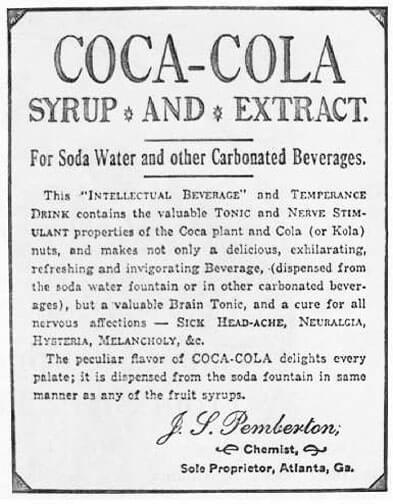On May 29th, 1886, John Pemberton ran the first advertisement for Coca-Cola.
Pemberton had created his tasty elixir some years earlier in the wake of the US Civil War. The drink eventually found its footing as a fountain beverage.
The first ad ran in the Atlanta Journal touting Coca-Cola’s delicious flavour resulting from the properties of the Coca plant and Cola nuts.
The ad had little impact and Pemberton was forced to find something more persuasive.
The result was this ad:

Pemberton may or may not have realized it at the time, but this ad is a classic example of the content marketing, as we now know it.
Instead of a short ad touting “Delicious! Refreshing!” the new ad told more of a story. There was background information, which was mentioned briefly in the first ad, but this time there was more to the story explaining how the new syrup could be added to fountains the same way other syrups were added.
This is content marketing. It’s educating a target audience and telling a story to grab their attention.
Over 100 years later, Coca-Cola is going strong as they continue to invest in content marketing (see: Coca-Cola 2020).
The First Rule Of Content Marketing: Building Trust
Coca-Cola needed a way to sell its syrup drink, but nobody knew what Coca-Cola was.
Salespeople used their words (content) to communicate with customers. They would introduce themselves. They would ask questions. They would provide answers. Trust was established.
People are more likely to comply to a request if they trust you. That’s just a fact.
Today, and in the past few decades, new communication channels have been developed—the printed word, radio, television, and now the Internet, which some can argue is the most powerful of them all. We have more opportunities now to create and distribute all different types of content than we ever did before, and companies are using the different channels, Internet especially, to share expertise and build trust.
The action steps below outline a few simple ways you can begin to earn the trust of your customers.
Action Steps:
– Understand who you are creating content for and why you’re creating that content in the first place. The best way to build trust is to first understand what your customers value most.
– Put information in places where your target audience is most likely to see it, whether that’s via email, social media, or some other channel.
– Draft content with an informal tone. When a customer reads it, you want them to feel like they’re chatting with you over a cup of coffee.
– Make accessing your content easy, and don’t be afraid to shout-out your new blog posts over social media. Just don’t get too spammy.
Content Marketing Today

Fast Internet connections.
User-friendly devices.
These two things have made information freely available to people all over the world. After all, the time we live in has been called The Information Age or The Information Revolution.
People have always demanded information, and companies are finding that they can grow businesses by creating the content people demand.
This is what we see as content marketing today. It’s companies creating information in various formats (video, images, memes, blog posts, and white papers) for a target group of people.
When you read the term “content marketing” today, the person is talking about all the ways companies can share information with a target customer with the aim of earning their attention and trust with the end result being a long-term profitable business and customer relationship.
At a high level, there are three key elements you need to consider before first developing a content marketing strategy. I’ll touch on each three and provide a few action steps to help you get started.
Finding Your Audience
When you’re marketing with content, it’s not about finding any audience; it’s about finding the audience—the one that will resonate with your content the most and hopefully spread the word about your products or services. You can’t be all things to all people. No one can. Which is why finding a niche audience and sticking with them is the best decision you can make with your content marketing strategy. It’s better to engage more with fewer users than it is to engage less with more users.
Action Steps:
– Start with your data, and look at demographics. Who is visiting your site (or blog) most often? Who is liking and sharing your posts on social media? Where are they from? Are they sharing other types of content?
– Join already-established communities. Follow a blog, join a Google+ Community, or start commenting on a group in LinkedIn. Then listen and observe to find that perfect audience you can start connecting with.
Finding What Your Audience Wants
Finding your audience is only one part of the battle. Another part is understanding what your audience wants. Of course, the better you get to know your target audience, the more specifically you can address their needs. This is also where your creativity comes in. Steve Jobs once said, “You can’t just ask customers what they want and then give it to them. By the time you get it built, they’ll want something new.”
In truth, customers don’t know what they want. They know what they don’t want—the problems they face everyday. It’s your duty to find a way to solve those problems through the content you share.
Action Steps:
– If you’re already blogging, look at your most popular posts. Look for trends. Do they like lists? How-tos? Video? This is a great way to see what your audience already likes.
– If you’re just starting to release content, sit down and brainstorm common pain points for your customers. Talk to your sales reps—they know better than anyone what questions customers are always asking and what they’re always struggling with.
Finding The Best Channel To Reach Your Audience
If you’re not careful, your content will get lost in the black hole that is the Internet. You need to hone in on the right channels to reach your customers.
Sometimes it can be as simple as looking at customer behavior. If they’re not active on Facebook, then don’t use Facebook as your main channel.
Other times it’s a little more complicated and you have to look at which types of content your customers prefer through the different channels. Maybe they prefer longer pieces of content via email, while on your blog they like articles that are short and sweet.
Here are a few steps you can take to help identify the best channels to reach your audience.
Action Steps:
– Like I just briefly touched on, look into how active customers on the various social networks, keeping in mind that Pinterest (obviously) is for the more visual users, Twitter is for information-seekers, and Facebook is a little bit of both.
– Use a tool to measure this engagement to get more accurate data to work with.
What Would The World Look Like Without Content Marketing
To imagine a world without content marketing would be to imagine a world without communication, commerce, and relationships.
That’s what many companies are doing today with their online businesses or the online portions of their businesses.
When you leave static and stale websites online you’re setting yourself up for disappointment by missing out on an opportunity.
We live in a global economy. There is more competition than ever before, which is great for consumers.
Consumers have more choice, and they’re demanding more information from companies. The companies that are providing all kinds of information in various forms of content (articles, videos, podcasts, studies, etc.) are earning the trust of consumers, and they’re winning business.
Some companies are pretending that the world doesn’t have content marketing. These companies can still win business with traditional face-to-face interaction, but they’re missing the bigger opportunity.
The world is a big place, but the Internet has made it small.
With the Internet, every company has the opportunity to grow. The way to do that is with content marketing.
A Few Useful Examples
A content strategy is about finding the balance between your own channel and the channels others have built that already have an established audience.
You can build a great website that has guides, blog posts and videos, but if you don’t have an audience you’re going to have to go where your audience is and you’ll have to give them something as a way to get them to come back to your website.
Businesspeople use a specific strategy that builds their own channel while tapping into existing audiences.
Authors use this strategy. When they write a new book they’ll create a website with all kinds of background information and usually will have a way for people to purchase the book. To get people to come to the website the author will allow a newspaper or popular online news site to publish an entire chapter of the book.
Celebrity chefs use the same strategy. They’ll host a show on a major television channel. They’ll give away a few secrets with each show as they gain exposure to the channel’s audience. That will entice people to visit the chef’s website where they can get more detailed information like recipes and instruction videos.
Base your content strategy on your own platform. Then tap into existing audiences by offering snippets of information that are valuable to other audiences. That’s how you will build an audience that will turn into customers.
Action Steps:
– Develop short-term and long-term goals. Where are you now? Where do you want to be? And how are you going to get there? There isn’t a platform in the world that didn’t start with zero readers, followers, and likes.
– Share content consistently. It’s a marathon, not a sprint. You’ll eventually see progress.
Final Takeaways
Over 100 years ago, Coca-Cola began investing in content marketing.
It wasn’t known as content marketing back then, but Coca-Cola was one of the first companies to use content to connect with potential customers.
Learn from the companies that have come before you. Here are a few major takeaways I want you to remember.
1) Communication channels are continually evolving—take advantage of this and be proactive.
2) It’s all about your audience. Understand them inside and out so you can provide real value.
3) Develop a platform, and constantly look for ways to improve that platform. The content marketing landscape is always changing.
What do you think the world would look like without content marketing?
Leave a comment sharing your favorite example!




